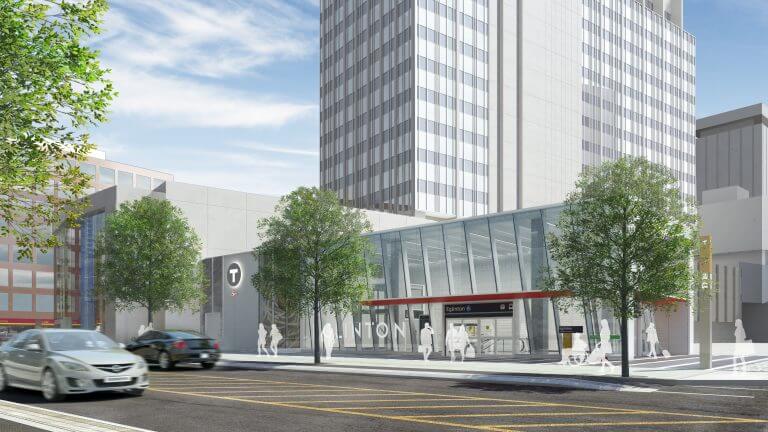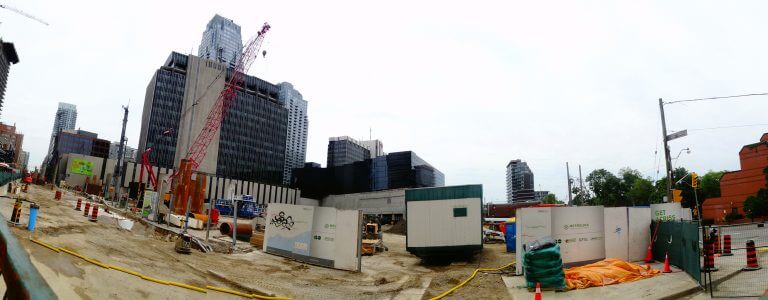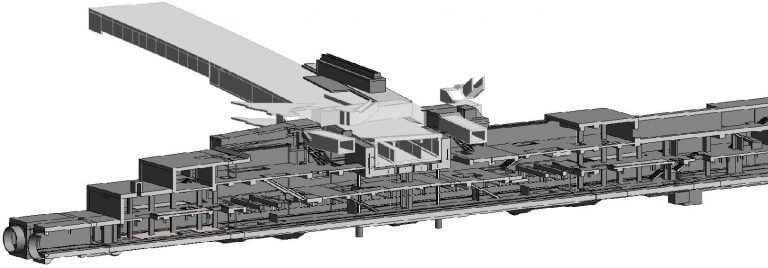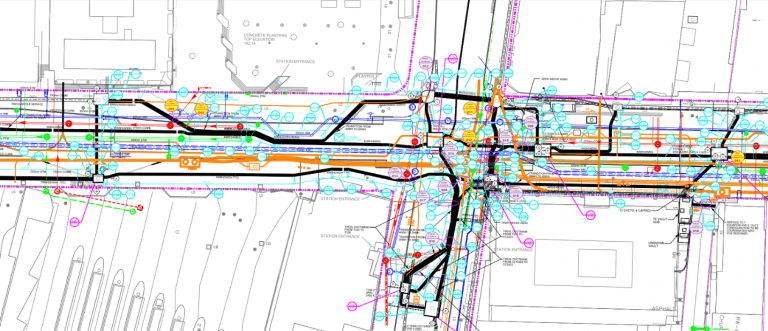
Render of one of the new Eglinton Crosstown LRT subway stations in downtown Toronto provided by Metrolinx.
LEA Consulting Ltd., as part of the Crosslinx Transit Solutions (CTS) team of Contractors, Engineers and Architects, continues to carry out work for the largest transit project underway in Canada – the multi-billion-dollar Eglinton Crosstown LRT (ECLRT) project. LEA is responsible for structural engineering of 3 underground stations (Eglinton Interchange, Avenue Road and Forest Hill) and for wet utility design at the Yonge-Eglinton site. After five years (2014 to 2018) of completed work on the project, an additional three years of construction remains.

A wide angle shot of the construction site at one of the new subway stations.
The project team recently presented an update on the Eglinton Interchange Station to the Metrolinx board specifically detailing how the team is managing the risk of building a new LRT line underneath the existing subway line, and how the existing structure will be supported during construction. As the largest, and most complex station on the Crosstown project, the Interchange station requires the team to excavate and build the ECLRT line 13.5 metres below the TTC subway, maintaining operation on Toronto’s busiest existing transit line during each work stage.
The project agreement sets extremely stringent performance criteria for work. Led by a tier 1 design and construction team, a solution was created that limits the differential settlement of the existing TTC structure to an absolute maximum of 3 millimeters. In other words, the existing station is closely monitored, and even a very small amount of movement will be addressed, well before a potential safety concern can develop.

Cross-section rendering of the Eglinton Interchange station, showcasing how the new expansion will add on to the existing subway infrastructure.
After the existing structure is supported, the new fully integrated exchange station is being built in a 275-metre-long x 22-metre-deep “cut and cover” excavation. Features include underpinning at the Yonge-University TTC Subway, one main and three secondary entrances, integrated emergency egress and FFA, two new TTC TVS fan plant buildings (one at Berwick Portal and one under Yonge Street north of Eglinton), a crossover track structure, a replacement headquarters for the Toronto Salvation Army, and installation of numerous new vertical circulation connections into TTC’s Eglinton Subway Station to harmonize passenger flow between the two transit lines.

A colourful map of all utilities that will require complex skills and work to be done for the ECLRT to be a success.
At the site, a complex arrangement of existing hydro duct banks, water, sewer, telecon and other utilities exist above the ECLRT station excavation. An integrated solution was developed to temporarily relocate or support-in-place, upgrade and restore all utilities, engineered to suit “support-of-excavation” pile installations required to build the long underground station.
The overall project is the largest of its kind in Canada, and rigorous validation and risk management practices are in place at every stage of work to ensure such a large project is managed and completed safely and successfully. We are proud of our employees’ critical contribution to the success of the project and look forward to our continued work on this monumental infrastructure development.
Project Background:
This Eglinton Crosstown LRT Project is for the design, financing and construction of a new 19-kilometre transit line along the major E-W Eglinton Avenue arterial road. Construction includes 15 underground transit stations, a vehicle storage and maintenance facility and 10 at-grade stops, along with 30 years of maintenance and repair.
LEA Contact:

Peter Ojala, P.Eng.
Lead Structural Engineer – Eglinton Interchange Station
pojala@lea.ca

Mohammad Majdabadi, P.Eng.
Senior Structural Engineer – Avenue Road and Forest Hill Stations
mmajdabadi@lea.ca

Steve Holyk, P.Eng.
Senior Structural Engineer – Salvation Army HQ, TTC Fan Plant Buildings, TTC Station Retrofit, and Transit Interchange Connections
sholyk@lea.ca

Adriano Costa
Wet Utilities Lead – Eglinton Interchange Station
acosta@lea.ca